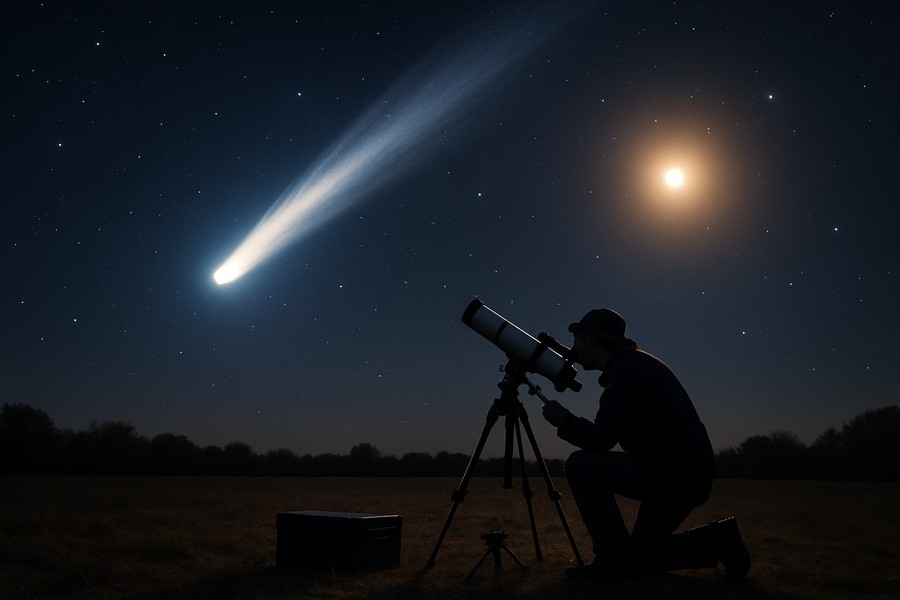
Observing Interstellar Comet 3I/ATLAS at Its Closest Approach
The interstellar comet, known as 3I/ATLAS, has been grabbing the attention of astronomy enthusiasts. Despite a flurry of speculative videos, there's no mystery surrounding this comet. The U.S. space agency is simply not providing updates due to the government shutdown. As a result, amateur astronomers have taken up the task of keeping an eye on this fascinating celestial object.
What We Know About 3I/ATLAS
Discovered in the summer, 3I/ATLAS caught the attention of astronomers due to its high orbital eccentricity, which indicates that it is an object from outside our solar system. Observable features of the comet include a coma, a dust tail, and other typical attributes of a comet. The comet is a rare visitor from outside our solar system and is certainly captivating.
Early observations of 3I/ATLAS showed a condensed coma with an offset pointing towards the Sun. As months passed, the comet began to develop an extended tail moving away from the Sun, suggesting the presence of dust particles slowly moving under the influence of solar radiation pressure.
A Classic Comet Feature and a Color Change
Interestingly, the comet has started to exhibit a green hue because of the emission of diatomic carbon, which is a common occurrence in comets. This means that 3I/ATLAS is behaving much like any other comet, despite its unique interstellar origins.
According to data, 3I/ATLAS appears to originate from the thick disk of the Milky Way and is likely a very ancient object, older than our solar system. It is moving at a remarkably fast speed of 58 kilometers per second relative to the Sun, which is too quick for us to catch up. The comet is expected to reach its closest approach to the Sun soon.
Visibility and Trajectory of 3I/ATLAS
The comet won't be visible from Earth until after its closest approach to the Sun, at which point it will appear low on the horizon in the early morning. The trajectory of 3I/ATLAS is noteworthy due to its low inclination against the ecliptic, moving in a retrograde path inclined at just five degrees. However, this isn't an exceptional fact in itself.
While the comet's trajectory has sparked some speculation, it's important to remember that the simplest explanation is often the correct one. There's no solid evidence to suggest anything extraordinary about 3I/ATLAS; it appears to be a fairly standard comet, albeit with a fascinating interstellar backstory.
Close Encounter with Mars
3I/ATLAS recently passed closer to Mars than it will to Earth. Spacecraft on and orbiting Mars were ready to observe the comet, which led to some rumors about its appearance. However, these rumors were quickly debunked by those familiar with basic astrophotography.
Upcoming Observations of 3I/ATLAS
The European Space Agency is also planning to monitor the comet. A spacecraft en route to Jupiter will begin monitoring the comet at a distance of about 0.4 Astronomical Units starting in early November.
As the comet moves away from the Sun, the best opportunities for viewing it will be in late fall and early winter. Although it will never become much brighter than +11th magnitude, it will be within range of large backyard telescopes as it moves through the constellations of Virgo and Leo. After its visit to our solar system, the comet will continue its journey through deep interstellar space towards the constellation Gemini.
The Future of Interstellar Object Research
3I/ATLAS is only the third interstellar comet observed visiting the inner solar system. Unlike its predecessors, it was discovered while it was still a significant distance from the Sun. As our technology improves, we should expect to see more of these interstellar visitors in the near future.
Without a doubt, the interstellar comet 3I/ATLAS is a fascinating object to study, even without resorting to wild speculation. As a famous author once said, "A garden is amazing enough, without having to believe that there are fairies in it, too."
